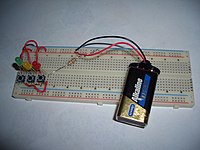Breadboard: Difference between revisions
No edit summary |
|||
| Line 19: | Line 19: | ||
==Use of the term in software engineering== |
==Use of the term in software engineering== |
||
A '''breadboard prototype''' (also known as an '''evolutionary prototype''') is an iteratively designed piece of software designed to evolve into a full-fledged system. This contrasts with a throwaway prototype (often associated with a proof-of-concept) that is discarded. |
A '''breadboard prototype''' (also known as an '''evolutionary prototype''') is an iteratively designed piece of software designed to evolve into a full-fledged system. This contrasts with a throwaway prototype (often associated with a proof-of-concept) that is discarded. |
||
== Other rapid prototyping tools for electronics == |
|||
* [http://team.lu/legoelectronic/photos4.html Lego Electronic Lab Kit] |
|||
* [http://elm-chan.org/docs/wire/wiring_e.html Progressive Wiring Techniques] |
|||
* [http://www.makezine.com/blog/archive/2005/12/how_to_build_a_pcb_router.html PCB router], [http://www.halfbakery.com/idea/Open_20Source_20Hardware_20Initiative PCB router] [http://www.lpkfusa.com/RapidPCB/CircuitboardPlotters/c20.htm PCB router] |
|||
* [[wire wrap]] |
|||
* [http://www.qrp.pops.net/ugly.htm dead bug] |
|||
* [http://www.wsu.edu/~jackdoll/jak/qanda/howto/how.htm "rat's nest"] |
|||
* [http://www.geofex.com/Article_Folders/protostyles/proto_styles.htm Effects Building Techniques] lists several other techniques |
|||
==Trivia== |
==Trivia== |
||
| Line 26: | Line 35: | ||
==See also== |
==See also== |
||
* [[Printed Circuit Board]] |
|||
* [[Stripboard]] |
|||
* [[Iterative design]] |
* [[Iterative design]] |
||
Revision as of 13:02, 25 January 2007
- This article deals with the device used in electronics labs. There is also an article on optical breadboards used in optics labs. For the food preparation utensil, see Cutting board.

A breadboard is a reusable solderless device used to build a (generally temporary) prototype of an electronic circuit and for experimenting with circuit designs. This is in contrast to stripboard (veroboard) and similar prototyping printed circuit boards, which are used to build more permanent prototypes or one-offs, and cannot easily be reused. A typical breadboard will have strips of interconnected electrical terminals, known as bus strips, down one or both sides—either as part of the main unit or as separate blocks clipped on—to carry the power rails.
A modern solderless breadboard consists of a perforated block of plastic with numerous tin plated phosphor bronze spring clips under the perforations. Integrated circuits (ICs) in dual inline packages (DIPs) can be inserted to straddle the centerline of the block. Interconnecting wires and the leads of discrete components (such as capacitors, resistors, inductors, etc.) can be inserted into the remaining free holes to complete the circuit topology. In this manner, a variety of electronic systems may be prototyped, from small circuits to complete central processing units (CPUs). However, due to large stray capacitance (from 2-25pF per contact point), solderless breadboards are limited to operating at relatively low frequencies, usually less than 10 MHz, depending on the nature of the circuit.
Naming history



The breadboard derives its name from an early form of point-to-point construction. In the early days of radio, amateurs would nail copper wire or terminal strips to a wooden board (often literally a board for cutting bread), and solder electronic components to them. Sometimes a paper schematic diagram was first glued to the board as a guide to placing terminals, components and wires.
Alternatives
Alternative methods to create prototypes are point-to-point construction, reminiscent of the original breadboards, wire wrap, and boards like stripboard. Complicated systems, such as modern computers comprising millions of transistors, diodes and resistors, do not lend themselves to prototyping using breadboards, as sprawling designs on breadboards can be difficult to lay out and debug. Modern circuit designs are generally developed using a schematic capture and simulation system, and tested in software simulation before the first prototype circuits are built on a printed circuit board. Integrated circuit designs are a more extreme version of the same process: since producing prototype silicon is expensive, extensive software simulations are performed before fabricating the first prototypes. However, breadboard prototyping techniques are still used for some specialised applications such as broadband RF circuits, or where software models of components are inexact or incomplete.
Use of the term in software engineering
A breadboard prototype (also known as an evolutionary prototype) is an iteratively designed piece of software designed to evolve into a full-fledged system. This contrasts with a throwaway prototype (often associated with a proof-of-concept) that is discarded.
Other rapid prototyping tools for electronics
- Lego Electronic Lab Kit
- Progressive Wiring Techniques
- PCB router, PCB router PCB router
- wire wrap
- dead bug
- "rat's nest"
- Effects Building Techniques lists several other techniques
Trivia

The integrated circuit for the Polaroid SX-70 camera was breadboarded before Texas Instruments fabricated the custom chip. It was rumoured to have been built from discrete components on a 4 ft. x 8 ft. piece of plywood, and was fully functional. The project was so secret that Texas Instruments engineers were only given functional specifications, but not told the purpose of the chip.[citation needed]
